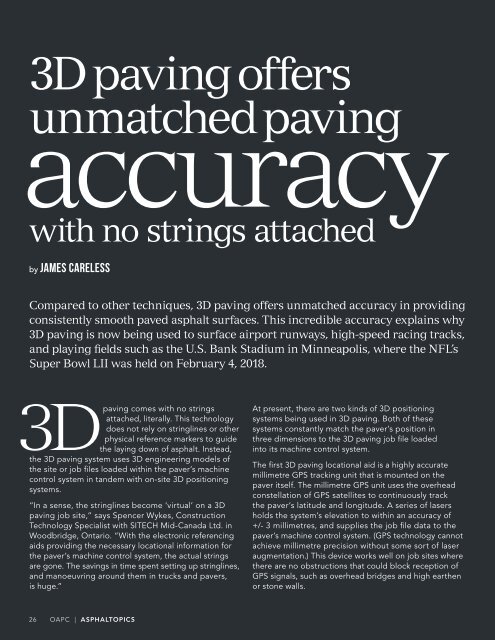ASPHALTopics | Spring 2018 | VOL 31 | NO 1
You also want an ePaper? Increase the reach of your titles
YUMPU automatically turns print PDFs into web optimized ePapers that Google loves.
3D paving offers<br />
unmatched paving<br />
accuracy<br />
with no strings attached<br />
by James Careless<br />
Compared to other techniques, 3D paving offers unmatched accuracy in providing<br />
consistently smooth paved asphalt surfaces. This incredible accuracy explains why<br />
3D paving is now being used to surface airport runways, high-speed racing tracks,<br />
and playing fields such as the U.S. Bank Stadium in Minneapolis, where the NFL’s<br />
Super Bowl LII was held on February 4, <strong>2018</strong>.<br />
3D<br />
paving comes with no strings<br />
attached, literally. This technology<br />
does not rely on stringlines or other<br />
physical reference markers to guide<br />
the laying down of asphalt. Instead,<br />
the 3D paving system uses 3D engineering models of<br />
the site or job files loaded within the paver’s machine<br />
control system in tandem with on-site 3D positioning<br />
systems.<br />
“In a sense, the stringlines become ‘virtual’ on a 3D<br />
paving job site,” says Spencer Wykes, Construction<br />
Technology Specialist with SITECH Mid-Canada Ltd. in<br />
Woodbridge, Ontario. “With the electronic referencing<br />
aids providing the necessary locational information for<br />
the paver’s machine control system, the actual strings<br />
are gone. The savings in time spent setting up stringlines,<br />
and manoeuvring around them in trucks and pavers,<br />
is huge.”<br />
At present, there are two kinds of 3D positioning<br />
systems being used in 3D paving. Both of these<br />
systems constantly match the paver’s position in<br />
three dimensions to the 3D paving job file loaded<br />
into its machine control system.<br />
The first 3D paving locational aid is a highly accurate<br />
millimetre GPS tracking unit that is mounted on the<br />
paver itself. The millimetre GPS unit uses the overhead<br />
constellation of GPS satellites to continuously track<br />
the paver’s latitude and longitude. A series of lasers<br />
holds the system’s elevation to within an accuracy of<br />
+/- 3 millimetres, and supplies the job file data to the<br />
paver’s machine control system. (GPS technology cannot<br />
achieve millimetre precision without some sort of laser<br />
augmentation.) This device works well on job sites where<br />
there are no obstructions that could block reception of<br />
GPS signals, such as overhead bridges and high earthen<br />
or stone walls.<br />
26 OAPC | ASPHALTOPICS

















